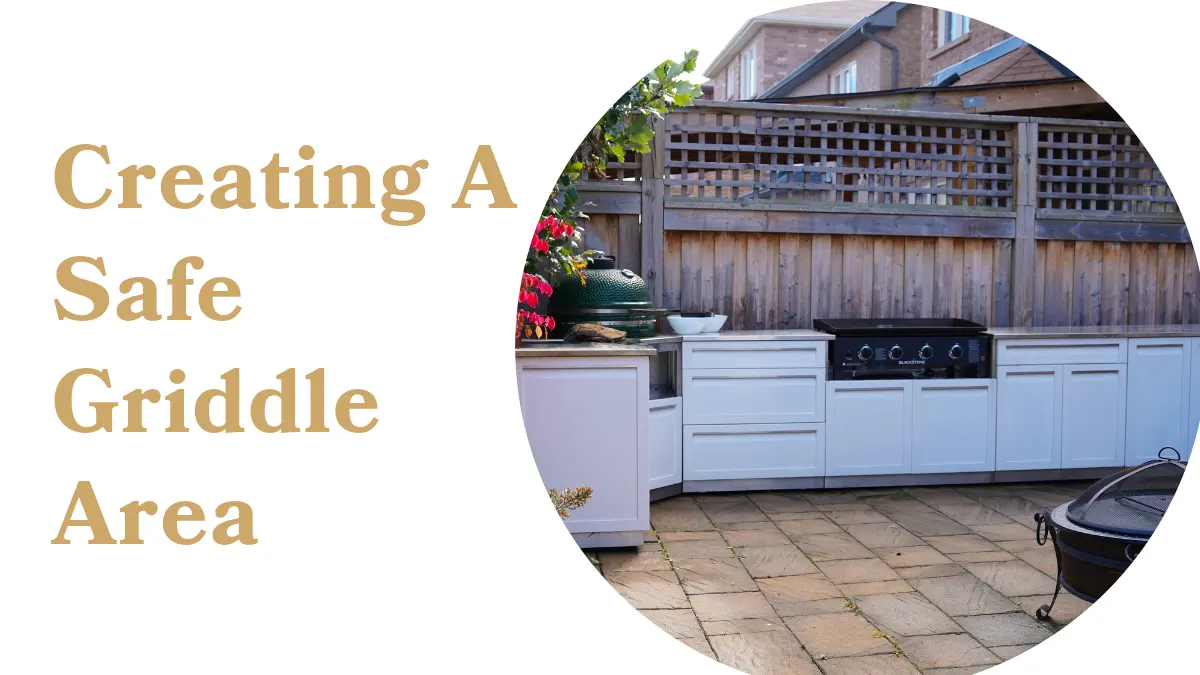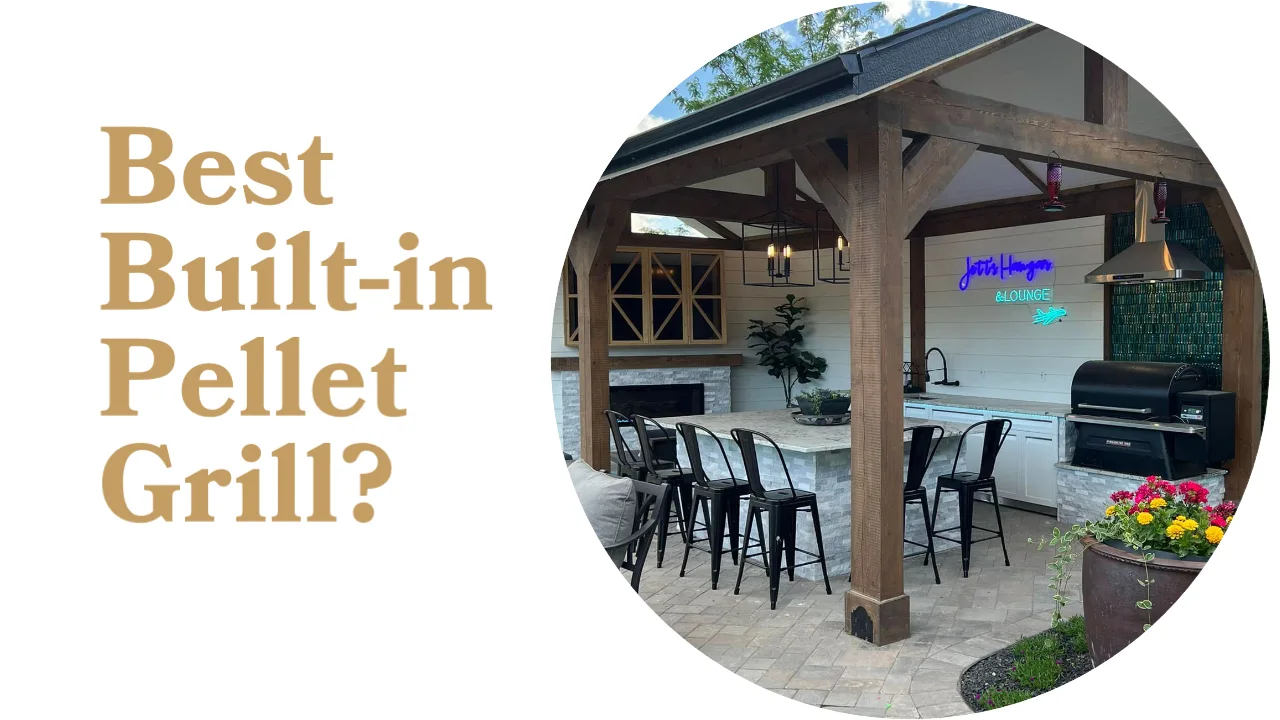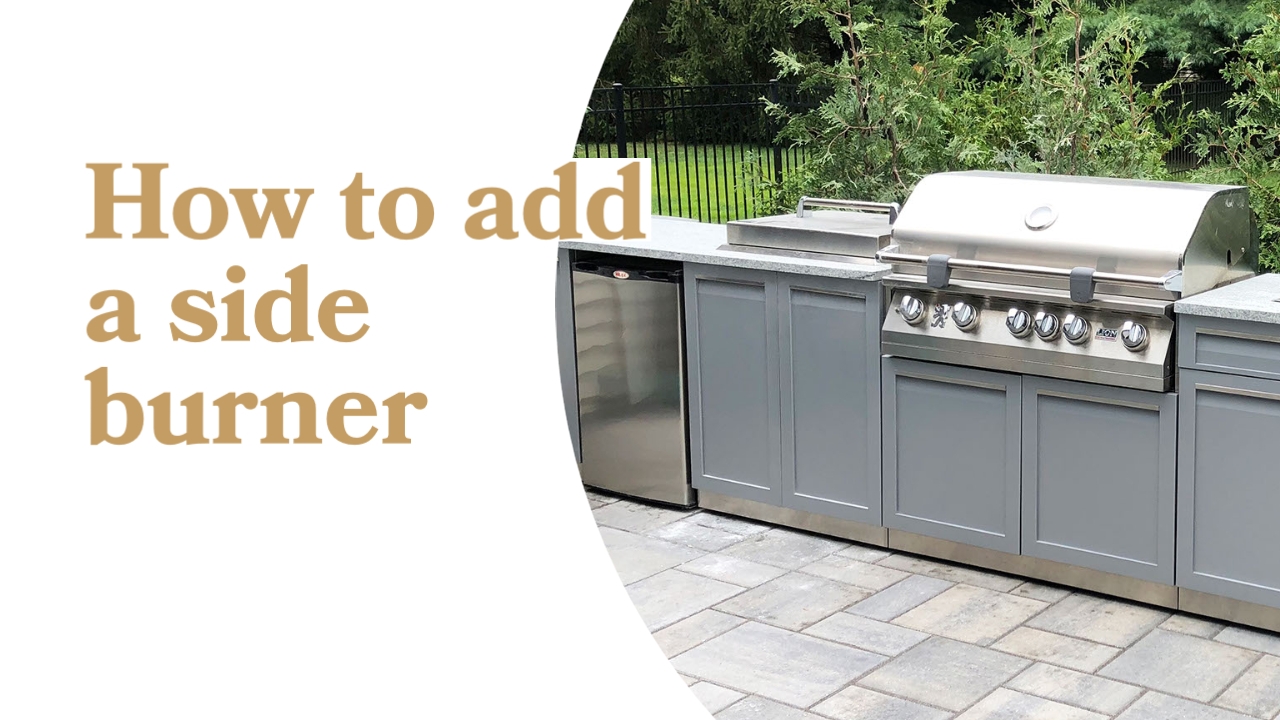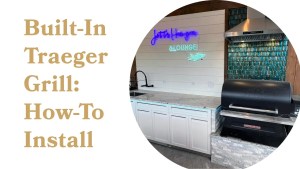The Importance of Choosing the Right Backsplash Materials
Central to the outdoor kitchen’s functionality and beauty is the backsplash, a key element that goes beyond mere decoration.
The choice of material for your outdoor kitchen backsplash is crucial for several reasons. It influences not only the kitchen’s visual appeal but also its longevity and ease of maintenance.
A well-chosen backsplash can elevate the ambiance of your outdoor cooking space, making it a focal point for gatherings.
Moreover, it plays a protective role, guarding the walls against smoke, grease, and other outdoor elements. The challenge, however, lies in finding a material that combines durability, aesthetic appeal, and practicality.
This is especially important in an outdoor setting, where the conditions are markedly different from those indoors.
Let’s review the various consideration for your backsplash, the best materials and tips for maintenance and upkeep.
Quick links:
1. Key Considerations for Selecting Outdoor Kitchen Backsplash Materials
-
-
- Durability: The Need for Weather-Resistant Materials
- Maintenance: Importance of Easy-to-Clean and Stain-Resistant Materials
- Aesthetic Appeal: Enhancing the Overall Look of the Outdoor Kitchen
- Safety: Non-Flammable and Heat-Resistant Materials Near Grills or Cooktops
-
2. Top Material Options for Outdoor Kitchen Backsplashes
-
-
- Stainless Steel as an Outdoor Kitchen Backsplash Material
- Natural Stone (Granite, Slate, Marble) for Outdoor Kitchen Backsplashes
- Ceramic and Porcelain Tiles for Outdoor Kitchen Backsplashes
- Glass Tiles for Outdoor Kitchen Backsplashes
- Concrete for Outdoor Kitchen Backsplashes
-
3. Innovative and Alternative Backsplash Ideas
4. Installation Tips and Tricks
-
-
- Professional vs. DIY Installation Considerations
- Preparing for Weather-Related Expansion and Contraction
- Proper Sealing and Grouting Techniques for Outdoor Conditions
-

Key Considerations for Selecting Outdoor Kitchen Backsplash Materials
When designing an outdoor kitchen, selecting the right backsplash material is not just about style. It’s a balance of durability, maintenance, aesthetics, and safety.
Let’s delve into these crucial considerations:
Durability: The Need for Weather-Resistant Materials
-
Resisting the Elements
-
- Broad Spectrum of Weather Conditions: Outdoor kitchens are exposed to a variety of weather conditions, including intense sunlight, heavy rain, frost, and snow. The backsplash material must be resilient enough to withstand these varying climates without losing its aesthetic appeal or structural integrity.
- UV Resistance: Prolonged exposure to sunlight can lead to fading and degradation of some materials. UV-resistant materials are essential to maintain the color and texture of the backsplash.
- Moisture and Temperature Resistance: The material should be able to handle moisture from rain and humidity without warping or deteriorating. It should also be able to withstand temperature fluctuations, especially freeze-thaw cycles, which can cause cracking and splitting in less durable materials.
-
Maintenance: Importance of Easy-to-Clean and Stain-Resistant Materials
The choice of backsplash material in outdoor kitchens should prioritize ease of maintenance to enhance the enjoyment and utility of the space.
-
Low Maintenance Needs
-
- Ease of Cleaning: Outdoor kitchens are spaces for leisure and entertainment. Therefore, the backsplash materials should be easy to clean, requiring minimal effort to maintain their appearance. Materials that can be wiped down quickly and efficiently after cooking or gatherings are ideal.
- Stain Resistance: Outdoor cooking and exposure to the elements can lead to stains. Materials that naturally resist staining or can be easily cleaned help keep the space looking pristine without extensive effort.
- Less Frequent Upkeep: Materials that require less frequent deep cleaning or resealing are preferable. This allows for more time to be spent enjoying the outdoor kitchen rather than maintaining it.
-
-
Weather and Stain Resistance
-
- Enduring Outdoor Conditions: Backsplash materials must be capable of withstanding not just cooking-related spills and splatters but also environmental factors like rain, humidity, and pollution.
- Mold and Mildew Resistance: In outdoor settings, the prevalence of moisture can lead to the growth of mold and mildew. Materials resistant to these will ensure a healthier and cleaner kitchen environment.
- Fade Resistance: Exposure to sunlight can cause some materials to fade over time. Choosing UV-resistant materials ensures that the backsplash retains its color and vibrancy.
-
-
Ideal Choices
-
- Glazed Ceramic Tiles: These tiles are coated with a protective layer that makes them impervious to water and stain penetration, making them ideal for outdoor use.
- Porcelain: Porcelain tiles are denser and less porous than ceramic tiles, offering excellent water and stain resistance. They are also highly durable and can mimic the look of other materials like wood or stone.
- Sealed Natural Stones: While natural stones like granite and slate are inherently durable, sealing them enhances their stain resistance. Regular resealing can keep them impervious to stains and water damage.
- Stainless Steel: This material is not only durable but also extremely easy to clean. It is highly resistant to stains and can be wiped down with basic cleaning agents.
-
-
Additional Considerations
-
- Grout Choice: The grout used between tiles is also an important consideration. Epoxy grout, for instance, is more resistant to stains and easier to clean than traditional grout.
- Textured Surfaces: While they add visual interest, textured surfaces can trap dirt and grease, making them more challenging to clean. Smooth surfaces are generally easier to maintain.
- Color Selection: Lighter colors might show stains more easily than darker or patterned options, which can be more forgiving with outdoor dirt and cooking spills.
-
Aesthetic Appeal: Enhancing the Overall Look of the Outdoor Kitchen
The aesthetic appeal of an outdoor kitchen’s backsplash is more than just its immediate appearance. It’s about creating a space that resonates with the environment, reflects personal style, and makes a statement, either by blending in harmoniously or standing out as a distinctive feature. This section of the article will help readers understand how the right backsplash can transform the look and feel of their outdoor kitchen.
-
Complementing the Environment
-
- Harmony with Nature: A well-chosen backsplash should resonate with the outdoor setting. For instance, natural stone can echo the surrounding landscape, while glass tiles can reflect the sky and surroundings.
- Matching Home Exteriors: The backsplash should also complement the home’s exterior design. A material that mirrors the architectural style of the house creates a sense of continuity between indoor and outdoor spaces.
- Color Coordination: Selecting colors that blend with the outdoor palette ensures the kitchen feels like a natural extension of the outdoor space, rather than an isolated element.
-
-
Personalization and Style
-
- Reflecting Personal Taste: The backsplash offers a unique opportunity to showcase individual style. It’s a space where homeowners can make a statement, whether through bold patterns, vibrant colors, or unique textures.
- Thematic Consistency: For a cohesive look, the backsplash can align with a chosen theme. For example, bright Mediterranean tiles for a lively, festive atmosphere, or sleek stainless steel for a minimalist, modern vibe.
- Material Selection: The choice of material plays a key role in personalization. Rustic bricks can create a traditional, warm feel, while polished granite might lend a more sophisticated and elegant touch.
-
-
Visual Impact: Focal Point of the Outdoor Kitchen
-
- Artistic Expression: The backsplash can act as a canvas for artistic expression. Mosaic tile designs, for instance, can add an artistic touch, turning the backsplash into a piece of art.
- Highlighting Key Areas: Strategically placed backsplash materials can draw attention to specific areas, like the cooking or prep zone, enhancing the kitchen’s functionality and aesthetic.
- Integration vs. Contrast: There’s a choice between making the backsplash seamlessly integrate with the overall design or using it to create a striking contrast that captures attention. This decision can dramatically alter the kitchen’s visual dynamics.
-
Safety: Non-Flammable and Heat-Resistant Materials Near Grills or Cooktops
When it comes to safety in outdoor kitchens, the choice of backsplash material is critical. Non-flammable, heat-resistant materials are essential to prevent fire hazards and protect the structural integrity of the kitchen.
-
Fire Safety
-
- Non-Flammable Materials: Safety is paramount in areas where cooking is involved. The backsplash material near grills and cooktops must be inherently non-flammable to prevent the risk of fire hazards.
- Withstanding High Temperatures: The material should be able to endure high temperatures from cooking equipment without deteriorating, warping, or emitting harmful substances.
- Preventing Fire Spread: In case of accidental flare-ups from the grill or cooktop, the backsplash material should be capable of containing the fire and preventing it from spreading.
-
Heat Resistance
-
- Direct Heat Endurance: Materials that are exposed to direct heat from grills or cooktops must maintain their integrity and appearance. This includes resistance to cracking, discoloration, and structural damage.
- Insulating Properties: The backsplash should act as a thermal barrier, reducing heat transfer to the wall structures behind it. This is crucial for both safety and preserving the integrity of the kitchen’s infrastructure.
- Heat Absorption and Dissipation: Some materials can absorb and dissipate heat more effectively, reducing the risk of heat damage to surrounding areas and materials.
-
Suitable Materials
-
- Stone: Natural stones like granite and slate are excellent choices due to their high heat resistance and durability. They do not catch fire and can withstand the heat from grills.
- Brick: Brick is another suitable material, known for its fire-resistant properties. It offers a traditional aesthetic while providing excellent heat resistance.
- Ceramic and Porcelain Tiles: High-quality ceramic and porcelain tiles are capable of withstanding high temperatures without damage. They are also non-flammable, making them safe for use near cooking areas.
- Stainless Steel: Stainless steel is not only heat resistant but also non-flammable, making it a safe and modern-looking choice for backsplashes near heat sources.
-
Additional Safety Measures
-
- Proper Installation: Ensuring that the backsplash materials are installed correctly is vital for safety. This includes using the right adhesives and sealants that can withstand high temperatures.
- Regular Inspection: Regularly checking for any damage or deterioration in backsplash materials can preemptively address safety concerns.
- Compliance with Safety Standards: When selecting materials, it’s important to choose those that meet fire safety standards and building codes, especially in areas designated for cooking.
Need Free Design Help? Reach out to us — we're here to offer free design advice and answer all your outdoor kitchen queries!
Top Material Options for Outdoor Kitchen Backsplashes
Each of these materials brings its unique set of qualities to an outdoor kitchen backsplash, and the right choice largely depends on the specific needs, climate, and design preferences of the space.
Stainless Steel as an Outdoor Kitchen Backsplash Material
- Pros:
- Durability:
- Weather Resistance: Stainless steel is exceptionally resistant to various weather conditions, including rain, humidity, and extreme temperatures, making it an excellent choice for outdoor environments.
- Corrosion Resistance: Its chromium content forms a passive protective layer that prevents rust and corrosion, which is especially beneficial in coastal areas or places with high humidity.
- Longevity: Stainless steel maintains its integrity over time, ensuring that the backsplash remains in excellent condition for years.
- Ease of Cleaning:
- Non-Porous Surface: The smooth, non-porous surface of stainless steel makes it resistant to stains and easy to clean. Spills and splatters can be quickly wiped away without leaving stains.
- Hygienic Option: Its non-porous nature also makes it resistant to bacteria and germs, an essential feature for a cooking area.
- Modern Look:
- Aesthetic Appeal: Stainless steel offers a sleek, contemporary look that can complement various design styles, from modern and minimalist to industrial.
- Reflective Surface: Its shiny, reflective surface can brighten the outdoor kitchen area and create an illusion of more space.
- Durability:
- Cons:
- Scratch and Dent Prone:
- Visible Wear: While stainless steel is durable, its surface can be susceptible to scratches and dents from kitchen utensils or abrasive cleaning tools.
- Maintenance of Appearance: These marks can detract from the sleek appearance, requiring careful handling and specific cleaning tools to maintain its pristine look.
- Heat Conduction:
- Heat Absorption: Stainless steel can absorb and conduct heat, becoming quite hot to the touch when exposed to direct sunlight. This aspect needs consideration in outdoor kitchen designs, especially in sunny climates.
- Safety Precautions: Care should be taken to avoid contact when the material is hot, and placement in the kitchen should be planned to minimize prolonged direct sun exposure.
- Scratch and Dent Prone:
Stainless steel is a highly durable, easy-to-clean, and aesthetically pleasing option for outdoor kitchen backsplashes, aligning well with modern design trends. However, its tendency to show scratches and dents and its heat conduction properties in sunlight are important considerations. With proper care and placement, stainless steel can be a long-lasting and visually appealing choice for outdoor kitchens.
Natural Stone (Granite, Slate, Marble) for Outdoor Kitchen Backsplashes
- Pros:
- Unique Beauty:
- Distinct Patterns and Colors: Each stone piece is unique, offering a range of patterns and colors. This natural variation adds a luxurious and sophisticated touch to any outdoor kitchen.
- Natural Aesthetics: The inherent beauty of these stones can create a seamless transition between the indoor and outdoor spaces, especially in settings that aim to blend with the natural landscape.
- Durability and Heat Resistance:
- Resilient to Outdoor Conditions: Natural stones like granite and slate are particularly known for their strength and durability, able to withstand harsh outdoor conditions.
- Heat Resistant: These materials are resistant to high temperatures, making them safe for use near grills and cooktops.
- Versatility:
- Wide Range of Options: Available in a variety of colors and finishes, natural stone can complement different design themes, from rustic to contemporary.
- Customizable Shapes and Sizes: They can be cut and shaped to fit specific design requirements, allowing for creative and unique backsplash designs.
- Unique Beauty:
- Cons:
- Porosity:
- Sealing Requirements: Stones like marble and some granites are porous and may require regular sealing to prevent stains and water damage.
- Maintenance: This sealing process needs to be repeated periodically to maintain the stone’s resistance to water and stains.
- Weight:
- Structural Considerations: Natural stone is heavy, and its use as a backsplash may require additional structural support, especially in larger installations.
- Installation Complexity: The weight also adds complexity to the installation process, often necessitating professional installation.
- Weathering:
- Color Changes: Some natural stones can change color or weather over time, especially when exposed to direct sunlight or extreme weather conditions.
- Wear and Tear: While this can add a desired patina in some designs, in others, it may be seen as a disadvantage if the original color and appearance are preferred.
- Porosity:
Glass Tiles for Outdoor Kitchen Backsplashes
- Pros:
- Reflective Beauty:
- Luminous Effect: Glass tiles have a unique ability to reflect light, adding a luminous quality and visual depth to the backsplash area. This can brighten the outdoor kitchen and create an appealing aesthetic.
- Enhanced Space Perception: The reflective nature of glass can make smaller outdoor kitchens appear larger and more open.
- Color Variety:
- Wide Range of Choices: Glass tiles come in an extensive array of colors, patterns, and translucencies, offering great flexibility in design. This allows for customization to match any color scheme or design theme.
- Vibrant Colors: The colors in glass tiles tend to be more vibrant and clearer compared to other materials, giving a more intense and striking visual impact.
- Ease of Cleaning:
- Non-Porous Surface: The non-porous nature of glass makes these tiles resistant to stains, mold, and mildew, which are particularly beneficial in outdoor settings.
- Simple Maintenance: Cleaning glass tiles usually requires just a wipe with a damp cloth, making them a convenient choice for a low-maintenance kitchen.
- Reflective Beauty:
- Cons:
- Brittleness:
- Fragility: Glass tiles are more fragile compared to materials like stone or ceramic. They can crack, chip, or shatter upon impact, which is a consideration in high-usage areas.
- Durability Concerns: The brittleness means they might not be the best choice for areas where heavy cooking utensils or appliances are used.
- Installation Sensitivity:
- Professional Installation Recommended: Installing glass tiles requires precision and care. It is often best done by a professional to ensure the tiles are properly set and aligned.
- Special Adhesives and Techniques: The installation process may require specific adhesives and techniques to prevent breakage and ensure a lasting finish.
- Brittleness:
- Additional Considerations:
- Thermal Expansion: Glass can expand and contract with temperature changes, so it’s important to ensure that the installation allows for this movement to avoid cracking.
- Sunlight and Color Fading: While glass is generally resistant to sunlight, certain colored glass tiles may fade over time when exposed to prolonged direct sunlight.
Glass tiles offer an attractive and versatile option for outdoor kitchen backsplashes, bringing reflective beauty, a wide range of colors, and ease of maintenance. However, their brittleness and the need for careful installation are important considerations to ensure a long-lasting and practical backsplash solution.
Concrete for Outdoor Kitchen Backsplashes
- Pros:
- Customization:
- Versatile Shapes and Designs: Concrete can be poured and molded into various shapes, allowing for custom designs that fit specific spaces and aesthetic preferences.
- Color Customization: It can be tinted with a wide range of colors or textured for a unique look, offering immense creative flexibility in design.
- Durability:
- Sturdy and Long-Lasting: Concrete is known for its strength and durability, making it ideal for withstanding harsh outdoor conditions including extreme temperatures and weather variations.
- Resilience: It’s a solid choice for an outdoor environment, resistant to wear and tear, and able to endure heavy usage over time.
- Contemporary Aesthetic:
- Modern and Industrial Look: Concrete backsplashes offer a modern, industrial aesthetic that can complement contemporary outdoor kitchen designs.
- Textural Element: The texture and tone of concrete can add a visually striking element to the kitchen, making it a focal point of the design.
- Customization:
- Cons:
- Sealing Required:
- Protection Against Stains and Water: While durable, concrete is porous and must be sealed to protect against stains and water absorption. This sealing needs to be maintained periodically.
- Maintenance Consideration: Regular resealing is required to maintain its appearance and functionality, which adds to the maintenance effort.
- Weight:
- Structural Support Needed: Concrete is heavy, and its use as a backsplash may require additional structural support, particularly in larger installations.
- Considerations in Installation: This weight factor can complicate installation, often necessitating professional assistance.
- Cracking:
- Potential for Hairline Cracks: Over time, concrete can develop hairline cracks. These are usually superficial but can be a concern for maintaining a pristine appearance.
- Aesthetic Impact: While some may find this adds character, others might view it as a flaw. It’s essential to consider this aspect in the context of the desired look for the kitchen.
- Sealing Required:
- Additional Considerations:
- Heat Resistance: Concrete is generally heat resistant, but prolonged exposure to high heat can cause damage, so placement near heat sources should be considered.
- Custom Finishes: There are various finishing options available, from polished to matte or textured, allowing further customization to match the kitchen’s overall style.
Concrete is a highly customizable, durable, and contemporary option for outdoor kitchen backsplashes. Its ability to be molded and colored offers unique design possibilities. However, its weight, the need for sealing and maintenance, and the potential for cracking are important factors to consider when deciding if concrete is the right choice for your outdoor kitchen project.
Innovative and Alternative Backsplash Ideas
The below innovative and alternative ideas for outdoor kitchen backsplashes push the boundaries of traditional design, allowing for creativity and personalization. From eco-friendly recycled materials to artistic mosaics and dynamic combinations of textures and colors, these options can transform the backsplash into a standout feature of any outdoor kitchen.
- Recycled Materials
- Eco-Friendly Choices:
- Sustainable Appeal: Using recycled materials for backsplashes is not only environmentally responsible but also adds a unique story to the kitchen design.
- Glass Tiles from Recycled Bottles: These can provide a colorful, light-reflective surface, and their variations in color and texture add depth and interest.
- Metal Tiles from Recycled Sources: Reclaimed metal, such as copper or aluminum, can offer a rustic or industrial look and develop a rich patina over time.
- Creative Reuse:
- Upcycled Ceramic or Porcelain: Broken pieces of ceramic or porcelain dishes can be reused to create an eclectic mosaic backsplash.
- Repurposed Materials: Using unexpected materials like reclaimed wood or repurposed industrial elements can result in a truly one-of-a-kind backsplash.
- Eco-Friendly Choices:
- Mosaic Designs
- Artistic and Personalized:
- Custom Artwork: Mosaic backsplashes allow for artistic expression. They can range from simple geometric patterns to elaborate scenes or abstract designs.
- Personal Touch: Homeowners can incorporate personal elements or themes, making the backsplash a focal point that tells a story.
- Material Diversity:
- Mix of Materials: Mosaics offer the flexibility to mix different materials like glass, stone, and ceramic, providing an opportunity to play with color, texture, and light.
- Versatile Application: They can be applied to curved surfaces or irregular areas, offering design flexibility that other materials may not.
- Artistic and Personalized:
- Combination of Materials
- Mixed-Material Backsplashes:
- Layered Aesthetics: Combining different materials like wood with metal, or glass with stone, can create a striking, multi-dimensional look.
- Contrast and Harmony: The interplay of textures and colors between different materials can add visual interest and depth to the kitchen’s design.
- Innovative Pairings:
- Modern and Traditional Mix: For example, pairing sleek stainless steel with rustic brick or weathered wood can create a balance between modern and traditional styles.
- Light and Shadow Play: Transparent or translucent materials like glass paired with solid materials can create interesting light effects, especially when backlit.
- Mixed-Material Backsplashes:
- Additional Unique Ideas
- LED-Backlit Backsplashes: Incorporating lighting into the backsplash can create ambiance and highlight the materials used.
- Living Walls: Integrating a vertical garden or living wall as a backsplash not only adds a green, lush element but also can be a source of fresh herbs for cooking.
- Themed Designs: Backsplashes that reflect a specific theme, like a coastal look with sea glass and shells, or a vineyard theme with incorporated wine corks, can add a personal touch.
Need Free Design Help? Reach out to us — we're here to offer free design advice and answer all your outdoor kitchen queries!
Installation Tips and Tricks for Outdoor Kitchen Backsplashes
Professional vs. DIY Installation Considerations
-
- Assessing Skill Level:
- DIY Viability: Simple tile installations might be manageable for those with moderate DIY skills, especially with the help of detailed tutorials and guides.
- Professional Expertise: More complex installations, particularly involving heavy or delicate materials like natural stone or glass, may require the precision and expertise of a professional.
- Cost vs. Quality:
- Budget Considerations: While DIY can be cost-effective, it’s important to consider the long-term quality and durability of the installation.
- Professional Assurance: Hiring a professional can ensure the job is done correctly the first time, potentially saving money on repairs or adjustments down the line.
- Assessing Skill Level:
Preparing for Weather-Related Expansion and Contraction
-
- Understanding Material Behavior:
- Thermal Expansion: Outdoor materials expand and contract with temperature changes. It’s crucial to choose materials and adhesives that can withstand this movement.
- Climate Considerations: In areas with significant temperature fluctuations, special attention should be given to the choice of materials and the method of installation.
- Allowing for Movement:
- Expansion Joints: Installing expansion joints in the backsplash can help accommodate movement and prevent cracking.
- Flexible Adhesives: Using flexible adhesives and grouts that can move with the materials can also mitigate the risk of damage due to expansion and contraction.
- Understanding Material Behavior:
Proper Sealing and Grouting Techniques for Outdoor Conditions
-
- Sealing for Protection:
- Porous Material Consideration: Materials like natural stone and concrete need to be sealed to protect against stains, water damage, and freeze-thaw cycles.
- Regular Maintenance: The sealant should be reapplied periodically, following the manufacturer’s recommendations, to maintain its effectiveness.
- Grouting for Durability:
- Weather-Resistant Grout: Use grout that is designed for outdoor use, which typically has enhanced resistance to moisture, temperature changes, and UV exposure.
- Proper Application: Ensure that the grout is applied correctly, filling all spaces between tiles completely to prevent water penetration and frost damage.
- Sealing for Protection:
- Additional Tips:
- Surface Preparation: The wall surface should be clean, dry, and level. Any irregularities can affect the installation’s integrity.
- Waterproofing Layers: In some cases, adding a waterproofing layer behind the backsplash can provide extra protection against moisture.
- Tool Selection: Using the right tools (tile cutters, trowels, spacers) is crucial for a successful installation, whether DIY or professional.
These installation tips and tricks are essential for ensuring a successful and lasting outdoor kitchen backsplash. Whether opting for DIY or professional installation, understanding the unique challenges of outdoor environments, such as weather-related expansion and proper sealing, is key to achieving a durable and aesthetically pleasing result.
Maintenance and Upkeep for Outdoor Kitchen Backsplashes
Regular Cleaning Routines for Different Materials
-
- Stainless Steel:
- Routine Cleaning: Wipe down with a soft cloth and a mixture of mild dish soap and water. For tougher stains, a specialized stainless steel cleaner can be used.
- Avoiding Scratches: Use non-abrasive tools like soft cloths or sponges to prevent scratching the surface.
- Natural Stone (Granite, Slate, Marble):
- Gentle Cleaning: Use a pH-neutral cleaner specifically designed for stone to avoid damaging the sealant.
- Periodic Resealing: Depending on the stone type, resealing every one to two years is recommended to maintain stain resistance.
- Ceramic and Porcelain Tiles:
- Regular Wiping: Clean with a mild detergent and water using a soft cloth or sponge. Rinse with clean water to remove soap residue.
- Grout Care: Grout lines should be cleaned with a grout cleaner to prevent staining and mold growth.
- Glass Tiles:
- Simple Maintenance: Glass tiles can be cleaned with a standard glass cleaner and a soft cloth to maintain their shine and prevent water spots.
- Concrete:
- Regular Sealing: Concrete should be sealed regularly to protect against stains. Clean spills promptly to prevent absorption.
- Mild Cleaning Solutions: Use a mild, pH-neutral cleaner to avoid damaging the concrete surface.
- Stainless Steel:
Seasonal Maintenance Tips to Prevent Damage
-
- Winter Preparation: In areas with freeze-thaw cycles, ensure that all backsplash materials are properly sealed to prevent water infiltration and subsequent cracking.
- Summer Upkeep: In hot climates, protect materials from prolonged sun exposure if they are prone to fading. Regular cleaning is also important due to increased outdoor activity.
Repair and Replacement Strategies
-
- Tile Backsplashes:
- Cracked Tiles: Individual cracked tiles can often be removed and replaced without redoing the entire backsplash.
- Grout Repair: Damaged or crumbling grout should be removed and reapplied to maintain the backsplash’s integrity and appearance.
- Stainless Steel and Metal Tiles:
- Minor Scratches: Light scratches can sometimes be buffed out using specific polishing compounds.
- Severe Damage: For significant dents or damage, panel replacement might be necessary.
- Stone and Concrete:
- Filling Cracks: Small cracks can be filled with a color-matched epoxy or resin. Larger issues may require professional repair.
- Resurfacing: In cases of extensive wear, stone and concrete backsplashes may be resurfaced by a professional.
- Tile Backsplashes:
Additional Considerations:
-
- Regular Inspections: Periodically inspect the backsplash for signs of wear, damage, or sealant failure.
- Avoid Harsh Chemicals: Harsh chemicals can damage many backsplash materials and should be avoided in favor of gentler cleaning solutions.
- Professional Advice: For complex materials or significant damage, consult a professional for the best repair or maintenance strategy.
Maintaining and caring for an outdoor kitchen backsplash requires an understanding of the specific needs of the chosen materials. Regular cleaning, seasonal maintenance, and timely repairs are essential for preserving the backsplash’s appearance and functionality. By following these guidelines, homeowners can ensure their outdoor kitchen remains a beautiful and enjoyable space for years to come.
Design Inspirations and Trends
Increased Functionality and Natural Materials:
- Trend towards Enhanced Capabilities: Outdoor kitchens in 2023-2024 are evolving beyond basic setups. People are seeking outdoor spaces that extend the functionality of their indoor kitchens. This includes integrated features like beverage centers, pizza ovens, or Teppanyaki griddles.
- Use of Sustainable Materials: There’s a growing trend towards using sustainable, natural materials. Homeowners are incorporating elements like granite countertops, stone finishes, and natural wood to make their outdoor kitchens more eco-friendly.
Colorful Cabinetry:
- Vibrant Colors for a Mood: Incorporating color into cabinetry is a trend for 2023. The choice of colors can create different moods, from a relaxing oasis to a lively party space. Options range from sleek and modern looks with clean white or black surfaces to more relaxed vibes with softer hues. Bold and bright colors are also popular for making a statement.
Mixing and Matching Materials:
- Bold Patterns and Colors: There’s a movement towards using bold patterns and vibrant colors in backsplashes. Geometric shapes and colorful mosaics offer numerous options for adding unique and eye-catching elements.
- Combining Different Materials: Mixing different types of tiles or incorporating elements like metal or glass into the design is becoming popular. This approach allows for a creative and personalized aesthetic that can be both stylish and functional.
Sustainability and Textured Backsplashes:
- Eco-friendly Options: With a focus on sustainability, backsplashes made from recycled materials or natural, renewable resources are gaining popularity. This aligns with the broader trend of eco-consciousness in home design.
- Textured Surfaces: Besides traditional flat tiles, textured backsplashes with raised or indented patterns are also trending. These add depth and interest to the kitchen space, offering a tactile and visually dynamic aspect to the design.
These trends highlight a shift towards more personalized, functional, and environmentally conscious choices in outdoor kitchen design. The use of bold colors, a variety of textures, and sustainable materials reflect a desire for outdoor spaces that are not only practical but also aesthetically appealing and in harmony with nature.
Need Free Design Help? Reach out to us — we're here to offer free design advice and answer all your outdoor kitchen queries!
Final Thoughts
The Importance of Selecting the Right Material
The journey through the world of outdoor kitchen backsplashes reveals a fundamental truth: the choice of material is pivotal. It’s not just a matter of aesthetics; it’s about finding a harmonious balance between durability, ease of maintenance, and style. The right backsplash material enhances the kitchen’s functionality, withstands the rigors of the outdoors, and complements the overall design.
A Reflection of Personal Style and Needs
As we conclude, it’s essential to remember that an outdoor kitchen is an extension of the homeowner’s personality and lifestyle. The backsplash, a central element in this space, should reflect the individual’s style and meet their specific needs. Whether the preference is for the natural elegance of stone, the modern sheen of stainless steel, or the eco-friendly charm of recycled materials, the choice should resonate with the homeowner’s aesthetic and practical requirements.
In essence, the perfect outdoor kitchen backsplash is one that not only stands up to the elements but also stands out as a testament to the homeowner’s taste and vision. By carefully considering the materials and embracing the latest trends and personal preferences, one can create an outdoor kitchen that is not just a cooking space, but a haven of beauty and enjoyment.
More From Our Blog:
Free Outdoor Kitchen Design Help.
Send us a picture and dimensions of your space to designhelp@4lifeoutdoor.com. We can place the cabinets into the picture for you to see exactly how it would all look!
Any help you need, we’re here to give our expertise.
Looking forward to hearing from you,
4 Life Outdoor team









